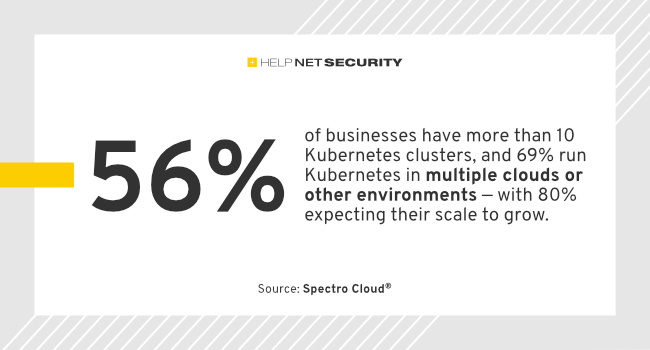Organizations lack the skills and headcount to manage Kubernetes
The Kubernetes industry is undergoing rapid change and evolution due to the growth of edge computing, the acceleration of AI, and the pressing need to modernize Kubernetes management in response to increasing technology scale and complexity, according to Spectro Cloud.

The realities of Kubernetes in enterprise
Kubernetes is inherently a complex technology, which is exacerbated further by the overall environment in which it exists. Production Kubernetes deployments usually include multiple clusters across multiple kinds of infrastructure, using multiple distributions, with multiple software in the associated stacks. Each of these adds further intricacy.
“With this research we get deep into what’s on the mind of those who are really working with Kubernetes in production in the enterprise,” says Dave Cope, CRO at Spectro Cloud. “From government CIOs to devops practitioners in retail, we made sure to represent the whole community, and spent time with them to understand how they really feel about Kubernetes and its impact on their organizations.”
“The survey didn’t just ask respondents to document what tools they use or how big their clusters are,” says Cope. “We explored evolving pain points, ambitions for the future, and attitudes to emerging trends.”
Ops teams struggle with growing complexity of Kubernetes environments
Given this complexity, it is not surprising that almost all stakeholders (98%) reported they face challenges when using Kubernetes in production. This number remains unchanged in the past year.
However, there is a shift in the type of issues faced in production Kubernetes environments. For 2023, one challenge is at the top of the list — putting in needed guardrails for enterprise production environments (48%)
56% of businesses have more than 10 Kubernetes clusters, and 69% run Kubernetes in multiple clouds or other environments — with 80% expecting their scale to grow.
Interoperability issues, both in day-to-day operations as well as events like configuration changes, upgrades, and patching, are unfortunately a fact of life for Kubernetes in production, with three in four (75%) saying they suffer these types of issues “regularly” or “occasionally.”
40% say they lack the skills and headcount to manage Kubernetes.
Respondents say they spend “too much” time on manual tasks like troubleshooting and patching, driving interest in automation as the #1 way to improve operations.
Despite the growth in the concept of platform engineering, 82% say their operations teams still struggle to give developers access to tailored clusters, and 37% say they suffer inconsistencies between dev, staging and production environments.
While 92% agree that devs should not be managing infrastructure, one in three say that developers today are building their own clusters to deploy applications.
62% are actively using or piloting tools designed to help app developers work with Kubernetes.
Cloud-native organizations grapple with application modernization
While interviewees unanimously told us they were “container first”, all agreed that virtual machines (VMs) are here to stay in their businesses.
85% said they were migrating existing VM workloads to Kubernetes, and 86% want to unify containerized and VM workloads on a single infrastructure platform.
To simplify the developer experience, a new class of tools has emerged to help engineers work more effectively in a Kubernetes environment.
Companies that have Kubernetes in production and are considering edge computing demonstrate a natural connection between those two innovations.
49% are actively piloting or using Kubernetes in edge computing environments. One in five expect “strong” growth in the coming year. Interviewees cited AI as a key driver for edge adoption, with investment in edge expected to improve business processes (50%) and enable new connected solutions (41%).
Significant challenges face those using edge, particularly security and compliance, field engineering costs and concerns about performing day-2 operations tasks.
“Kubernetes is here to stay, but as the scale of adoption grows, ops teams soon find themselves challenged struggling to support their internal customers while pursuing application modernization strategies and embracing the new opportunities of K8s at the edge,” says Cope.
“As the Kubernetes landscape evolves and enterprises push ahead into new frontiers, they are finding their legacy tools are no longer fit for purpose. A new generation of challenges demands a new generation of solutions,” Cope concluded.